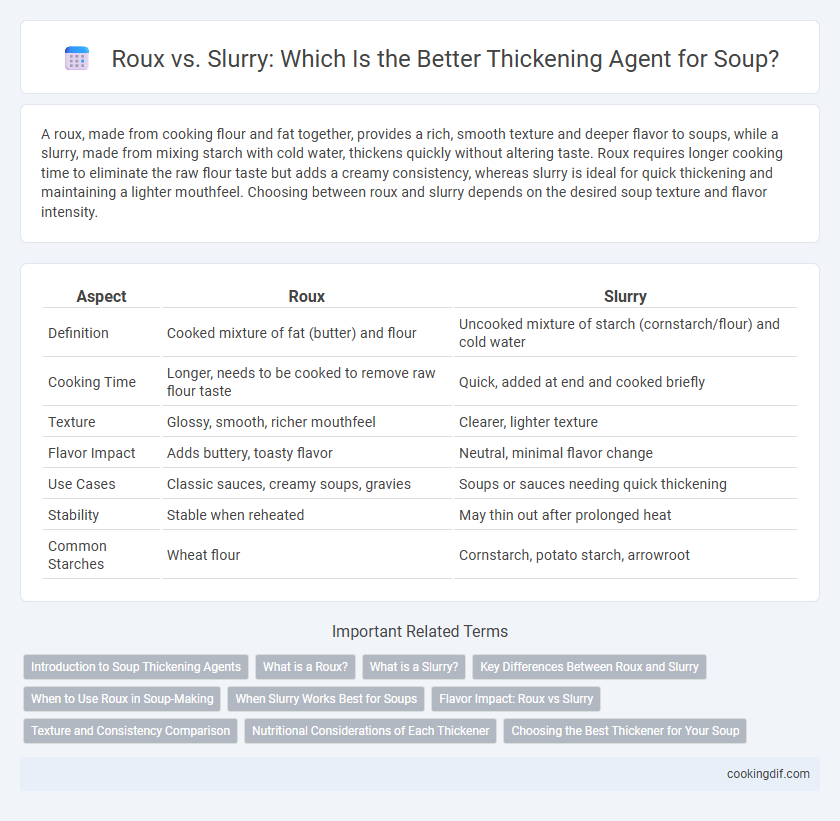A roux, made from cooking flour and fat together, provides a rich, smooth texture and deeper flavor to soups, while a slurry, made from mixing starch with cold water, thickens quickly without altering taste. Roux requires longer cooking time to eliminate the raw flour taste but adds a creamy consistency, whereas slurry is ideal for quick thickening and maintaining a lighter mouthfeel. Choosing between roux and slurry depends on the desired soup texture and flavor intensity.
Table of Comparison
| Aspect | Roux | Slurry |
|---|---|---|
| Definition | Cooked mixture of fat (butter) and flour | Uncooked mixture of starch (cornstarch/flour) and cold water |
| Cooking Time | Longer, needs to be cooked to remove raw flour taste | Quick, added at end and cooked briefly |
| Texture | Glossy, smooth, richer mouthfeel | Clearer, lighter texture |
| Flavor Impact | Adds buttery, toasty flavor | Neutral, minimal flavor change |
| Use Cases | Classic sauces, creamy soups, gravies | Soups or sauces needing quick thickening |
| Stability | Stable when reheated | May thin out after prolonged heat |
| Common Starches | Wheat flour | Cornstarch, potato starch, arrowroot |
Introduction to Soup Thickening Agents
Roux and slurry are two essential thickening agents used in soups to achieve the desired consistency and texture. Roux consists of equal parts flour and fat, typically butter, cooked together to form a smooth paste that adds richness and body to the soup. Slurry, made from a mixture of cornstarch and cold water, provides a quick and clear thickening effect without altering the soup's flavor or color.
What is a Roux?
A roux is a classic thickening agent made by cooking equal parts flour and fat, typically butter, to create a smooth paste used in soups and sauces. It provides a rich, velvety texture and imparts a nutty flavor that enhances the depth of the dish. Roux thickens liquids slowly and evenly, making it ideal for creamy or hearty soups like chowders and bisques.
What is a Slurry?
A slurry is a mixture of cold water and a starch-based thickening agent such as cornstarch or flour, used to thicken soups and sauces without clumps. It is typically added towards the end of cooking to create a smooth, glossy texture. Unlike a roux, a slurry does not require cooking fat and provides a quicker, lighter thickening option.
Key Differences Between Roux and Slurry
Roux and slurry are both common thickening agents used in soups, but they differ in composition and cooking method. Roux is made by cooking equal parts of flour and fat (usually butter) to create a cooked paste that adds depth and a nutty flavor, while slurry is a mixture of cold water and starch (like cornstarch or flour) used to thicken liquids quickly without altering the base flavor. Roux requires cooking time to eliminate the raw flour taste and often forms the soup's base, whereas slurry is added at the end of cooking to achieve instant thickening and clarity.
When to Use Roux in Soup-Making
Roux serves as an ideal thickening agent in soup-making when a rich, velvety texture and depth of flavor are desired, particularly in creamy or dairy-based soups like bisques and chowders. Cooking the flour and fat together allows the starch to properly gelatinize, preventing a raw flour taste and creating a smoother consistency compared to slurry. Roux is best used in recipes that require longer simmering to fully integrate the thickening agent, enhancing the overall mouthfeel and complexity of the soup.
When Slurry Works Best for Soups
Slurry works best for soups when you need a quick and clear thickening solution that doesn't alter the flavor or color, such as in delicate broths, vegetable, or chicken soups. It is ideal for recipes requiring gentle thickening at the end of cooking since it dissolves easily in cold water and integrates smoothly without clumping. Using a slurry composed of equal parts cornstarch and cold water maintains the soup's clarity and light texture, which is often desired in clear or mildly flavored soups.
Flavor Impact: Roux vs Slurry
Roux, made from equal parts fat and flour cooked together, imparts a rich, nutty flavor that deepens the complexity of soups, enhancing their overall taste profile. Slurry, a mixture of starch and cold water, thickens soup without altering its original flavor, making it ideal for maintaining a clean, light broth. Chefs often choose roux when a robust, velvety texture and added flavor are desired, while slurry serves as a neutral thickener best for delicate soups.
Texture and Consistency Comparison
Roux creates a smooth, velvety texture in soups by evenly coating starch granules with fat, resulting in a richer, more stable consistency that holds well even after reheating. Slurry, made from starch and liquid, thickens soups quickly but can produce a lighter, slightly translucent consistency that may separate over time or when exposed to prolonged heat. Choosing roux enhances mouthfeel and body, while slurry offers a faster thickening option with a more delicate texture.
Nutritional Considerations of Each Thickener
Roux contains flour and fat, delivering calories and some fat-soluble vitamins, which can add richness but increase fat content in soups. Slurry, made from starch and water, is low in fat and calories, suitable for lighter soups or those needing gluten-free options. Nutritionally, choosing between roux and slurry depends on dietary goals, such as reducing fat intake or avoiding gluten.
Choosing the Best Thickener for Your Soup
Choosing the best thickener for your soup depends on the desired texture and cooking time; a roux, made from equal parts fat and flour, provides a rich, velvety consistency and deep flavor, ideal for slow-simmered soups. In contrast, a slurry, typically a mixture of cornstarch and cold water, thickens quickly with a glossy finish, perfect for clear or vegetable-based soups needing minimal cooking. Understanding the differences in thickening power and flavor contribution helps achieve the perfect soup consistency.
Roux vs Slurry for thickening agent Infographic

 cookingdif.com
cookingdif.com